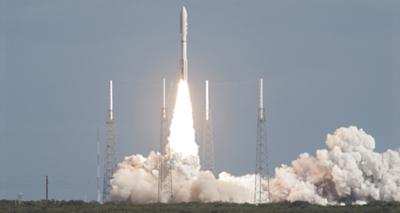Fri, Dec 16, 2011
Monitoring Radiation During Eight-Month Passage To Mars
NASA's car-sized Curiosity rover has begun monitoring space
radiation during its 8-month trip from Earth to Mars. The research
will aid in planning for future human missions to the Red Planet.
Curiosity launched on November 26 from Cape Canaveral, FL., aboard
the Mars Science Laboratory (MSL). The rover carries an instrument
called the Radiation Assessment Detector (RAD) that monitors
high-energy atomic and subatomic particles from the sun, distant
supernovas and other sources.

These particles constitute radiation that could be harmful to
any microbes or astronauts in space or on Mars. The rover also will
monitor radiation on the surface of Mars after its August 2012
landing. "RAD is serving as a proxy for an astronaut inside a
spacecraft on the way to Mars," said Don Hassler, RAD's principal
investigator from the Southwest Research Institute in Boulder,
Colo. "The instrument is deep inside the spacecraft, the way an
astronaut would be. Understanding the effects of the spacecraft on
the radiation field will be valuable in designing craft for
astronauts to travel to Mars."
Previous monitoring of energetic-particle radiation in space has
used instruments at or near the surface of various spacecraft. The
RAD instrument is on the rover inside the spacecraft and shielded
by other components of MSL, including the aeroshell that will
protect the rover during descent through the upper atmosphere of
Mars.

Spacecraft structures, while providing shielding, also can
contribute to secondary particles generated when high-energy
particles strike the spacecraft. In some circumstances, secondary
particles could be more hazardous than primary ones. These first
measurements mark the start of the science return from a mission
that will use 10 instruments on Curiosity to assess whether Mars'
Gale Crater could be or has been favorable for microbial life.
"While Curiosity will not look for signs of life on Mars, what it
might find could be a game- changer about the origin and evolution
of life on Earth and elsewhere in the universe," said Doug
McCuistion, director of the Mars Exploration Program at NASA
Headquarters in Washington. "One thing is certain: the rover's
discoveries will provide critical data that will impact human and
robotic planning and research for decades."
As of noon EST on Dec. 14, the spacecraft had traveled 31.9
million miles of its 352-million-mile flight to Mars. The
first trajectory correction maneuver during the trip is being
planned for mid-January. (Images Courtesy NASA)
More News
Aero Linx: Model Aeronautical Association of Australia MAAA clubs are about fun flying, camaraderie and community. For over 75 years, the MAAA has been Australia’s largest fl>[...]
Touchdown Zone Lighting Two rows of transverse light bars located symmetrically about the runway centerline normally at 100 foot intervals. The basic system extends 3,000 feet alon>[...]
“Discovery and innovation are central to our mission at Virgin Galactic. We’re excited to build on our successful record of facilitating scientific experiments in subor>[...]
How To Get A Story On Aero-TV News/Feature Programming How do I submit a story idea or lead to Aero-TV? If you would like to submit a story idea or lead, please contact Jim Campbel>[...]
Student Pilot Reported That During Rotation, “All Of A Sudden The Back Of The Plane Kicked To The Right..." Analysis: The student pilot reported that during rotation, “>[...]
 ANN's Daily Aero-Linx (05.02.24)
ANN's Daily Aero-Linx (05.02.24) ANN's Daily Aero-Term (05.02.24): Touchdown Zone Lighting
ANN's Daily Aero-Term (05.02.24): Touchdown Zone Lighting Aero-News: Quote of the Day (05.02.24)
Aero-News: Quote of the Day (05.02.24) ANN FAQ: Contributing To Aero-TV
ANN FAQ: Contributing To Aero-TV NTSB Final Report: Cirrus Design Corp SR20
NTSB Final Report: Cirrus Design Corp SR20




